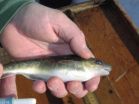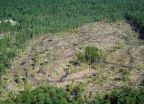(Press-News.org) Star formation is one of the most important processes in shaping the Universe; it plays a pivotal role in the evolution of galaxies and it is also in the earliest stages of star formation that planetary systems first appear.
Yet there is still much that astronomers don't understand, such as how do the properties of stellar nurseries vary according to the composition and density of the gas present, and what triggers star formation in the first place? The driving force behind star formation is particularly unclear for a type of galaxy called a flocculent spiral, such as NGC 2841 shown here, which features short spiral arms rather than prominent and well-defined galactic limbs.
In an attempt to answer some of these questions, an international team of astronomers is using the new Wide Field Camera 3 (WFC3) installed on the NASA/ESA Hubble Space Telescope to study a sample of nearby, but wildly differing, locations where stars are forming. The observational targets include both star clusters and galaxies, and star formation rates range from the baby-booming starburst galaxy Messier 82 to the much more sedate star producer NGC 2841.
WFC3 was installed on Hubble in May 2009 during Servicing Mission 4, and replaces the Wide Field and Planetary Camera 2. It is particularly well-suited to this new study, as the camera is optimised to observe the ultraviolet radiation emitted by newborn stars (shown by the bright blue clumps in this image of NGC 2841) and infrared wavelengths, so that it can peer behind the veil of dust that would otherwise hide them from view.
While the image shows lots of hot, young stars in the disc of NGC 2841, there are just a few sites of current star formation where hydrogen gas is collapsing into new stars. It is likely that these fiery youngsters destroyed the star-forming regions in which they were formed.
INFORMATION:
Notes
The Hubble Space Telescope is a project of international cooperation between ESA and NASA.
Image credit: NASA, ESA and the Hubble Heritage (STScI/AURA)-ESA/Hubble Collaboration Acknowledgment: M. Crockett and S. Kaviraj (Oxford University, UK), R. O'Connell (University of Virginia), B. Whitmore (STScI) and the WFC3 Scientific Oversight Committee.
More information
- Images of Hubble: http://www.spacetelescope.org/images/archive/category/spacecraft/
Contact
Oli Usher
Hubble/ESA
Garching, Germany
Tel: +49-89-3200-6855
Email: ousher@eso.org
Flocculent spiral NGC 2841
2011-02-18
ELSE PRESS RELEASES FROM THIS DATE:
Improving microscopy by following the astronomers' guide star
2011-02-18
A corrective strategy used by astronomers to sharpen images of celestial bodies can now help scientists see with more depth and clarity into the living brain of a mouse. Eric Betzig, a group leader at the Howard Hughes Medical Institute's Janelia Farm Research Campus, will present his team's latest work using adaptive optics for biology at the annual meeting of the American Association for the Advancement of Science in Washington, D.C. during a press conference on Thursday, Feb., 17, and a panel discussion on Friday, Feb. 18.
A key problem in microscopy is that when ...
Plants cloned as seeds
2011-02-18
Plants have for the first time been cloned as seeds. The research by aUC Davis plant scientists and their international collaborators, published Feb. 18 in the journal Science, is a major step towards making hybrid crop plants that can retain favorable traits from generation to generation.
Most successful crop varieties are hybrids, said Simon Chan, assistant professor of plant biology at UC Davis and an author of the paper. But when hybrids go through sexual reproduction, their traits, such as fruit size or frost resistance, get scrambled and may be lost.
"We're ...
Reverse genetics allow scientists to slow the spread of the Rubella virus
2011-02-18
Scientists have identified the gene that allows the Rubella virus to block cell death and reverse engineered a mutant gene that slows the virus's spread. Tom Hobman and a team of researchers at the University of Alberta's Faculty of Medicine and Dentistry believed that RNA viruses were able to spread by blocking the pathways in cells that lead to cell suicide, and isolated the responsible gene in Rubella, also known as German measles. They then created a mutant version of this gene that made the virus spread more slowly. These results are reported in PLoS Pathogens.
The ...
Engineering atomic interfaces for new electronics
2011-02-18
MADISON — Most people cross borders such as doorways or state lines without thinking much about it. Yet not all borders are places of limbo intended only for crossing. Some borders, like those between two materials that are brought together, are dynamic places where special things can happen.
For an electron moving from one material toward the other, this space is where it can join other electrons, which together can create current, magnetism or even light.
A multi-institutional team has made fundamental discoveries at the border regions, called interfaces, between ...
Identification of glaucoma gene brightens view for future therapies
2011-02-18
Glaucoma – a leading cause of vision loss and blindness worldwide – runs in families. A team of investigators from Vanderbilt University and the University of Florida has identified a new candidate gene for the most common form of the eye disorder, primary open angle glaucoma (POAG).
The findings, reported Feb. 17 in the open-access journal PLoS Genetics, offer novel insights into glaucoma pathology and could lead to targeted treatment strategies.
Elevated pressure inside the eye is a strong risk factor for POAG. Pressure increases because of increased resistance to the ...
Checklist cuts lethal ventilator-associated lung infections
2011-02-18
Cases of ventilator-associated pneumonia — the most lethal and among the most common of all hospital-associated infections — dropped by more than 70 percent in Michigan hospitals where medical staff used a simple checklist designed by Johns Hopkins researchers. Such pneumonias kill an estimated 36,000 Americans each year.
The findings, published online in the journal Infection Control and Hospital Epidemiology, show how a relatively simple series of steps, coupled with an education program and a culture that promotes patient safety, can save tens of thousands of lives ...
New Pitt projects will test brain computer interfaces for people with spinal cord injury
2011-02-18
PITTSBURGH, Feb. 17 – Researchers at the University of Pittsburgh have been awarded funding for two projects that will place brain-computer interfaces (BCI) in patients with spinal cord injuries to test if it is possible for them to control external devices, such as a computer cursor or a prosthetic limb, with their thoughts.
The projects build upon ongoing research conducted in epilepsy patients who had the interfaces temporarily placed on their brains and were able to move cursors and play computer games, as well as in monkeys that through interfaces guided a robotic ...
A genetic mutation allows Hudson River fish to adapt to PCBs
2011-02-18
NEW YORK, Feb. 17, 2011 – A research group led by a New York University School of Medicine scientist discovered a genetic variant that allows a fish in the Hudson River to live in waters heavily polluted by PCBs. In a study published in the February 18, 2011, online issue of Science, they report that a population of Hudson River fish apparently evolved rapidly in response to the toxic chemicals, which were first introduced in 1929, and were banned fifty years later. PCBs, or polychlorinated biphenyls, were used in hundreds of industrial and commercial applications, especially ...
Turning forests into fuel: New report outlines promise and limits of biomass energy in the Northeast
2011-02-18
(Millbrook, N.Y. – Feb 17, 2011) Forest biomass could replace as much as one quarter of the liquid fossil fuel now being used for industrial and commercial heating in the Northeastern United States. That's according to a new report released today by the Cary Institute of Ecosystem Studies.
But the report also has sharp caveats: The potential for forest biomass varies widely within the region, and forest resources must be carefully managed to protect the other important services and goods they provide. Under the right circumstances, however, the report found that forest ...
Unraveling how prion proteins move alon axons in the brain
2011-02-18
Researchers at the University of California, San Diego School of Medicine have identified the motors that move non-infectious prion proteins (PrPC) – found within many mammalian cells – up and down long, neuronal transport pathways. Identifying normal movement mechanisms of PrPC may help researchers understand the spread of infectious prions within and between neurons to reach the brain, and aid in development of therapies to halt the transport.
Their study is published in the February 18 edition of the journal Cell.
The small prion protein is found in the cell membrane ...



